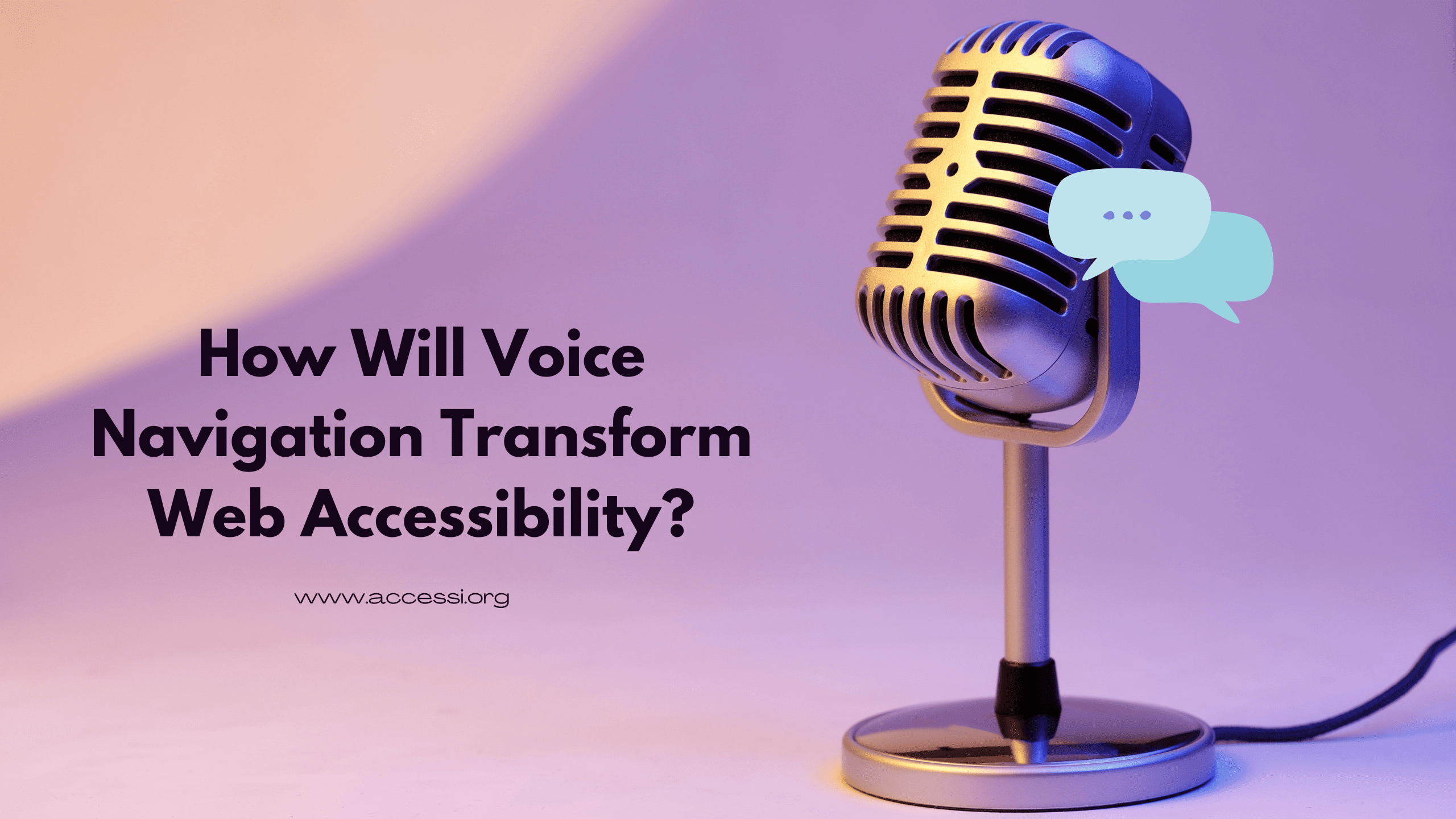How Will Voice Navigation Transform Web Accessibility?

In our increasingly digital world, web accessibility is a critical consideration. Ensuring that websites are usable by everyone, regardless of their abilities, is not only a legal requirement but also a moral imperative. One powerful tool that contributes to this inclusivity is voice navigation. Let’s explore how voice navigation transforms web accessibility and empowers users across the spectrum of abilities.
Voice navigation refers to using spoken commands to interact with websites and applications. Instead of relying solely on traditional mouse or keyboard input, users can navigate, search, and engage with content using their voice. This technology bridges the accessibility gap, making it easier for people with disabilities to access online information and services.
Is your website ADA-compliant? Test it for free 👉
Two notable categories of voice navigation technologies are:
Screen Readers with Voice Commands: Screen readers like JAWS and NVDA now incorporate voice navigation features. Users can issue commands verbally to navigate through web pages, read content, and interact with elements.
For example, a user can say,
“Read the heading of this article,”
and the screen reader will focus on the relevant content.
Browser-Based Voice Recognition: Modern browsers (such as Chrome and Firefox) support voice recognition APIs. Developers can integrate voice commands directly into web applications.
This allows users to interact with web content using natural language, enhancing the overall accessibility of websites.

Voice Technology as an Accessibility Tool
Aiding Users with Visual Impairments
- Hands-Free Interaction: Voice navigation allows users with visual impairments to interact with websites without relying on physical input devices. They can explore content, follow links, and perform spoken language actions.
- Contextual Information: Voice commands provide context. For example, a user can say,
“Read the heading of this article,”
and the screen reader will focus on the relevant content.
Benefits for Users with Motor Disabilities
- Reducing Physical Strain: Voice navigation alleviates the need for precise mouse movements or keyboard inputs. Users with motor disabilities can navigate more comfortably.
- Enhanced Efficiency: Voice commands streamline tasks. For instance, a user can say,
“Fill out the form”
instead of manually tabbing through fields.
Current State of Voice-Enabled Web Accessibility
The current state of voice-enabled web accessibility is marked by significant progress. Screen readers, such as JAWS and NVDA, now incorporate voice navigation features, allowing users to issue verbal commands to navigate web pages and interact with content. Additionally, modern browsers support voice recognition APIs, enabling developers to integrate voice commands directly into web applications. These advancements empower users with visual impairments, motor disabilities, and those seeking a hands-free experience, creating a more inclusive online environment.
Examples of Successful Voice Navigation Implementations

- Google Assistant: Integrates with websites to provide voice-based answers to user queries.
- Voice Search on Mobile Devices: Users can search the web using voice commands, demonstrating the practicality of voice technology.
Challenges and Limitations
- Accuracy: Voice recognition systems may misinterpret commands, especially for users with speech impediments or non-native accents.
- Privacy Concerns: Storing voice data raises privacy issues. Striking a balance between convenience and privacy is crucial.
Future Trends in Voice Accessibility
Adoption of IoT and Cloud Technologies
The proliferation of Internet of Things (IoT) devices has revolutionized voice communication. Billions of interconnected physical devices now rely on voice as the primary modality for interaction. Cloud technologies, coupled with AI and Machine Learning (ML), enable seamless integration of voice-enabled features across devices. This adoption is reshaping product experiences and creating new business ecosystems.
Psycholinguistic Data Analytics and Affective Computing
Advances in psycholinguistic data analytics allow us to infer emotions, attitudes, and intent from voice data. By analyzing speech patterns, tone, and context, we can understand users’ states of mind. Affective computing takes this a step further, enabling systems to respond empathetically based on emotional cues. Imagine voice assistants that adapt their tone based on whether you’re stressed, excited, or calm.
Enhanced Voice Recognition Accuracy
Breakthroughs in voice recognition technology are on the horizon. As AI models improve, voice assistants will understand and respond to human speech with unprecedented precision. This accuracy will enhance usability, making voice interfaces more reliable and efficient for users across diverse contexts.
Personalization and Context Awareness
AI-driven voice assistants will become more context-aware. They’ll remember previous interactions, adapt to user preferences, and provide personalized responses. Imagine a voice assistant that knows your habits, anticipates your needs, and seamlessly integrates into your daily life.
Multimodal Interaction
Voice won’t exist in isolation. Expect to see more multimodal interfaces that combine voice with other modalities like touch, gestures, and eye tracking. These interfaces will offer a holistic user experience, catering to different abilities and preferences.
Privacy and Ethical Considerations
As voice AI becomes more pervasive, privacy concerns will intensify. Striking a balance between convenience and data privacy will be crucial. Companies must handle voice data responsibly, ensuring transparency and user consent. The post-COVID world demands heightened scrutiny in this area.
Designing for Voice Accessibility
Best Practices
Natural Language Commands
Encourage users to speak naturally. Avoid rigid syntax requirements for voice commands. For example, instead of saying,
“Search for hotels,”
allow variations like
“Find hotels”
or
“Show me places to stay.”
Feedback and Confirmation
Provide audible feedback when a voice command is recognized. Confirm actions taken based on the user’s input. For instance, after a user says,
“Add to cart,”
respond with,
“Item added to your cart.”
Error Handling
Anticipate errors and guide users toward successful interactions. If a command is misunderstood, offer alternatives or ask clarifying questions. For example,
“I’m sorry, could you repeat that?”
or
“Did you mean X?”
Contextual Awareness
Leverage context to enhance voice interactions. If a user asks,
“What’s the weather like?”
and then follows up with
“In Seattle,”
the system should remember the context and provide relevant information.
Multimodal Design
Consider combining voice with other modalities (such as touch or gestures). Users may want to switch seamlessly between voice and touch interactions. Ensure consistency across modalities.
Privacy and Security
Address privacy concerns related to voice data. Clearly communicate how voice recordings are handled, stored, and secured. Obtain user consent for voice data collection.
Voice navigation should complement existing interaction methods, not replace them entirely. By following these best practices, you can create a more inclusive and user-friendly experience for all visitors.
Tools and Platforms That Support Voice Accessibility
- Tota11y: A web accessibility toolkit that includes voice navigation testing.
- Voiceflow: A platform for designing voice interactions.
- Speechactors: An online TTS AI platform that transforms written text into human-like speech. It offers over 300 AI-generated voices across 140 languages, including role voices inspired by movies, cartoons, anime, and celebrities. With features like advanced voice customization, it’s a reliable choice for creating voiceovers for presentations or listening to articles.
- Murf AI: A cloud-based platform that uses AI and deep machine learning to produce realistic text-to-speech voiceovers. It offers over 120 voices in more than 20 languages. Murf streamlines the voiceover process, making it easier for content creators to get high-quality audio for videos, podcasts, commercials, and e-learning materials.
- ReadSpeaker: While not specifically a voice navigation tool, ReadSpeaker is a web-based text-to-speech service that enhances accessibility. It caters to users with visual, cognitive, or learning impairments by offering voice-enabled navigation and control of web pages.
- Voice Platforms: Platforms like Amazon Alexa and Google Home provide voice interaction capabilities. Although they are not exclusively for web accessibility, they contribute to the conversational voice trend and can be harnessed for accessible experiences.
By incorporating these tools and platforms, developers can enhance web accessibility and ensure a more inclusive digital experience for all users.
Conclusion
As voice navigation continues to evolve, websites have the opportunity to prioritize the needs of all users. By embracing this technology, we pave the way for a digital landscape where accessibility is not an afterthought but a fundamental aspect of design. Let’s create a more accessible and user-friendly internet for everyone.
Share this article to enlighten your friends or colleagues 📚💡
Leave a Reply